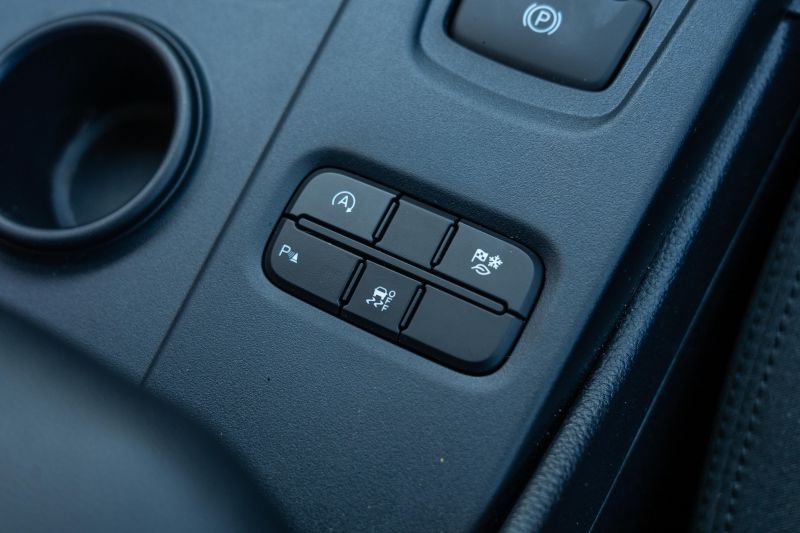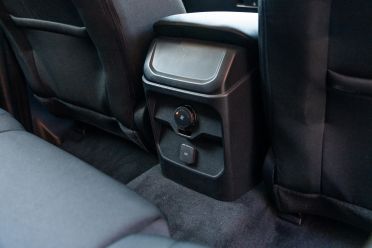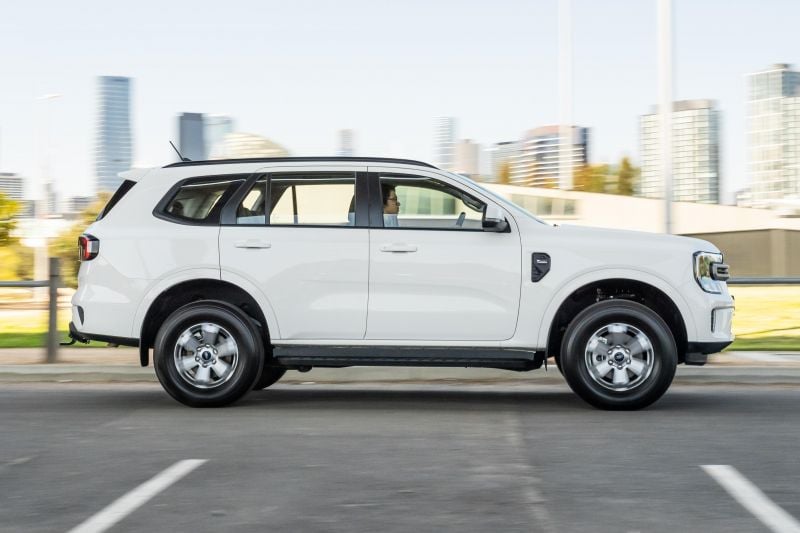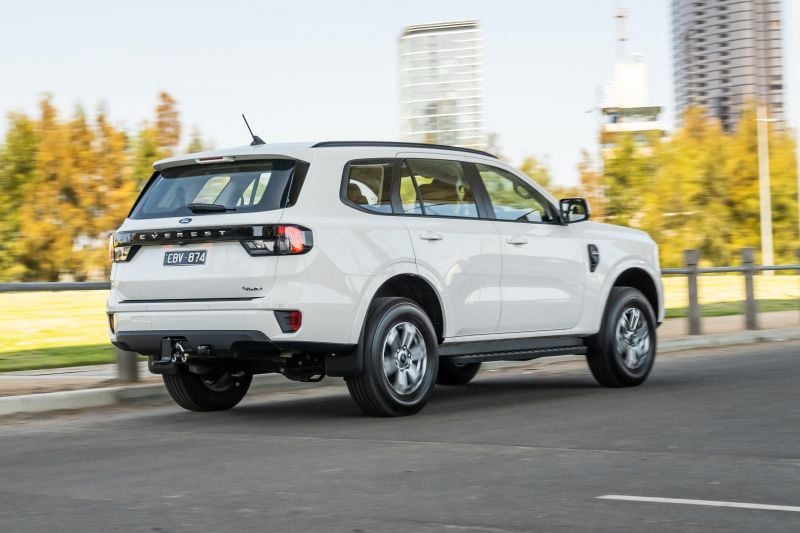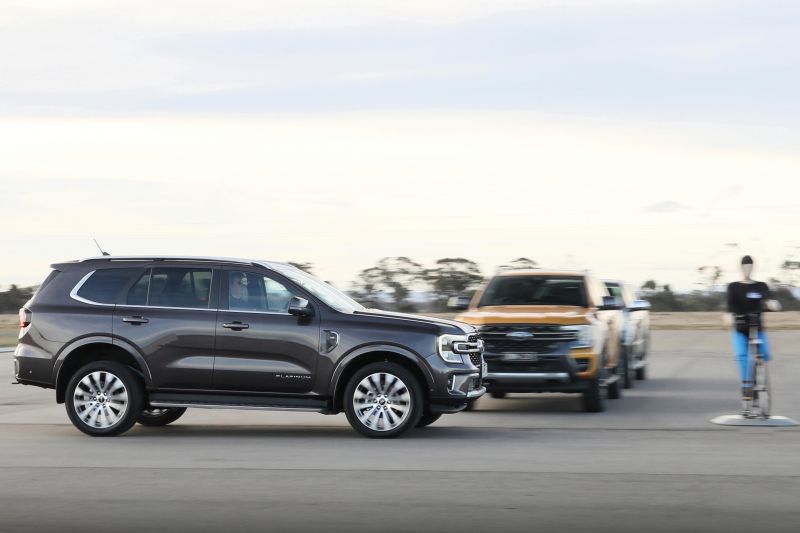The current-generation Ford Everest body-on-frame SUV has been on sale locally for roughly 12 months now, with the turbo-diesel V6 variants being in hot demand.
There are a growing number of variants in the Everest range, however the Ambiente 4×2 we have on test here is the cheapest version of the entry-level variant. It does have a couple of option boxes ticked though.
Ford Australia recently upped the pricing of the Everest by up to $1000 for vehicles produced from August 2023 onwards. There haven’t been any specification changes.
On the outside the Everest Ambiente can be distinguished by its 17-inch alloy wheels that are a version of what comes on the Ranger XLT. Another visual identifier is the lack of rear privacy glass.
The Everest goes up against stiff competition including body-on-frame Large SUV rivals including the Isuzu MU-X, LDV D90, Mitsubishi Pajero Sport, SsangYong Rexton, and Toyota Fortuner, among others. Given our tester is only two-wheel drive it also goes up against a wealth of unibody Large SUVs.
Does the Ford Everest still make sense without its full-time four-wheel drive system?
How much does the Ford Everest Ambiente 4×2 cost?
The Ford Everest Ambiente 4×2 is now priced from $53,490 before on-road costs for vehicles produced from August 2023 onwards.
Our tester came equipped with the optional Third Row Seat package which costs an additional $950, as well as the Towing package which adds $1700. It’s also finished in Arctic White exterior paint which is a no-cost option.
This brings the total cost our tester to $56,140 before on-road costs, or $62,075 drive-away for Victorian buyers (each state has different taxes).
Similarly priced Large SUV rivals with two-wheel drive and seven seats include:
All prices are before on-road costs, unless specified otherwise
It’s worth mentioning that at this price point there are also a wealth of all-wheel drive or four-wheel drive seven-seat Large SUV options.
These include:
All prices are before on-road costs, unless specified otherwise
You can get the Everest Ambiente with a full-time four-wheel drive system instead of rear-wheel drive, but this costs an additional $5000.
What is the Ford Everest Ambiente 4×2 like on the inside?
If you’ve already been in a new-generation Ranger, there aren’t really too many surprises here. There are, however, a couple of notable differences if you pay very close attention.
Walking up to and getting into the Ford Everest Ambiente there are thankfully a set of side steps as standard because it’s a fair way to get up and into. I found I had to do a couple of scoots to get comfortable in the driver’s seat.
All the seats in the Everest Ambiente are finished in black cloth upholstery which is to be expected given it’s the entry-level offering in the range.
The driver’s seat is extremely comfortable with plenty of side bolstering holding you in place. The headrest is really soft and supple too.
Although the driver’s seat only has manual adjustment I was able to get my driving position dialled in perfectly thanks in part to the adjustable lumbar support.
This great driving position was helped by the amount of tilt and reach adjustability the Everest’s steering column has. I have long legs and a shorter torso which typically means my knees hit the steering column and I have to stretch to reach the steering wheel.
Unfortunately the Everest Ambiente only comes with a plastic steering wheel which feels a little cheap in hand and slightly rental-spec. It would be nice to get a smoother leather-wrapped unit given its asking price.
In order to get a leather-wrapped steering wheel you need to step up to the Trend 4×2 which is an extra $7500.
Just like the Ranger, the Everest’s steering wheel buttons are a little spongey but the rocket switches have a precise and firm feel.
Ahead of the driver is an 8.0-inch digital instrument cluster that’s incredibly configurable, yet a little on the small side.
Although you miss out on the full 12.4-inch digital instrument cluster you need to step all the way up to the flagship Platinum to get, the 8.0-inch unit looks better than traditional dials with a tiny screen sandwiched between them. It still tells you all the critical information you need to know.
Moving across, the Everest Ambiente comes with a portrait-oriented 10.1-inch touchscreen infotainment system that looks very high-resolution but is an absolute fingerprint magnet. There’ll be even more smudgy fingerprints if you find the ‘Sketch’ section too.
The system itself appears to have enough processing power, which means it starts up and loads new pages pretty quickly. There were a few instances though where the screen would lag a bit when swiping or trying to do a few things at once.
Apple CarPlay and Android Auto are both available via wired and wireless connections. You can change between two sizes for the smartphone mirroring, with a larger squarer or smaller rectangular aspect ratio. The latter of these frees up a range of shortcut buttons.
Satellite navigation comes as standard on the entire Everest range and it’s extremely easy to use. Searching up points of interest takes no time at all, making the process feel natural and simple.
A strange part of the Everest’s interior, like the Ranger, is the climate control set-up. Parts are integrated into the touchscreen, whereas the other parts are physical buttons and knobs.
There’s a weird double of the temperature controls, with it able to be adjusted either by physical dials or by tapping the screen. I still don’t really see the point of having both…
Around the cabin of the Everest Ambiente there is a mixture of both softer and harder plastics. Thankfully the former of these is in high-traffic touchpoints like the armrests and the main section of the dashboard.
Harder plastics are a given in this entry-level variant but you don’t have to stray too far away from the armrests to find them.
As I mentioned at the beginning of this section, there are a few small differences between the Ranger and Everest that arguably make the latter better equipped.
Compared to the almost equivalently specified Ranger XLT, the Everest Ambiente receives the tradie-style cupholders that are mounted on the dashboard, an upper glovebox, as well as a wireless phone charger.
There are a couple of quirks or easter eggs hidden around the Everest’s interior as well, with the most notable being the chips holder in front of the gear selector.
Given this Everest on test is a two-wheel drive model, it not only ditches the e-shifter for a conventional mechanical gear shifter but it also goes without the rotary selector that’s typically used to change four-wheel drive modes.
What the Everest Ambiente 4×2 gets instead of the rotary selector is what I’d like to coin as a sauce holder to go alongside the chip holder. You’ll need to find yourself a round sauce container if you’d like to try this out for yourself.
Moving to the second row there’s a noticeable step down in terms of quality. The seats don’t feel quite as comfortable as the ones in the front row, though the door and fold-down centre armrests are still soft.
The second-row seats both slide and recline which allows second-row passengers to either relax or maximise cargo capacity.
At a leggy 182cm I expected a little more space in the second row as I need to splay my legs around the driver’s seat in order to sit comfortably. There was still enough head- and shoulder-room though.
In terms of second-row amenities there are thankfully a set of grab handles to allow for easier ingress and egress, a separate blower control with roof-mounted air vents, and a 12V socket.
The Everest Ambiente is the only variant that comes standard with five seats, though our tester came with the optional third-row package that brings the total amount of seats to seven.
Trying to get into the Everest’s third row is a mission in itself. I remember trying to do it the first time just after finishing a lower-body strength session at the gym and failed miserably.
The third-row seats should be considered an emergency, kids-only space for because there’s no knee, head or shoulder space for adults.
The armrests are absolutely rock hard and there’s an awkward cupholder space on each side of the car. One upside is there are roof-mounted vents that help blow air onto your face.
In terms of boot space, with the optional third row of seats upright there’s 259 litres of boot capacity which is actually still fairly usable. This expands an extremely generous 898 litres with the third-row folded away, and an almost van-like 1823 litres with both the second- and third-rows of seats folded.
Other little storage nooks include a small space off to the left-hand side of the boot, as well as a small covered section under the boot space where the tools are to lower the full-size spare wheel. It’s worth noting the Everest doesn’t come with a load cover which means you’ll need to be careful what you have in the car because they will be on display for everyone who walks past.
The Everest Ambiente comes with a manually-operated tailgate which is completely understandable given it’s an entry-level model, however, I often hit my head on it because it didn’t open high enough. I don’t remember having this issue on Everests with power tailgates.
One last thing to mention about the Everest Ambiente’s interior is the boot is incredibly lit up with a light on the right-hand side and another mounted on the tailgate. I wish more cars had the latter of these.
What’s under the bonnet?
The Ford Everest Ambiente is powered by a 2.0-litre Bi-Turbo four-cylinder diesel engine producing 154kW of power and 500Nm of torque.
This is mated to a 10-speed automatic transmission with drive in our tester sent through the rear wheels only. There is a version that has a full-time four-wheel drive system but this costs an extra $5000.
If you want the sought-after 3.0-litre turbo-diesel V6 engine you’ll need to step all the way up to the Sport variant which starts at $70,590 before on-roads, or almost $15,000 more than the car on test here.
The Everest Ambiente 4×2 comes with the following drive modes:
- Normal
- Eco
- Tow/Haul
- Slippery
The entire Everest range comes with a braked towing capacity of 3500kg, regardless of whether it’s two- or four-wheel drive. Maximum unbraked towing capacity is 750kg.
Claimed combined fuel economy for the Everest Ambiente 4×2 is 7.1 litres per 100km. During our time with the tester we achieved an average of 8.5 litres per 100km over 250km of largely unladen urban and highway driving. We did see closer to the claim along certain parts of freeways.
All Everest variants come with an idle stop-start system. It has an 80-litre fuel tank and also requires AdBlue.
How does the Ford Everest Ambiente 4×2 drive?
If you thought the Everest’s interior was like the Ranger’s, you shouldn’t be shocked to know how it drives is similar too.
The Everest Ambiente’s 2.0-litre four-cylinder Bi-Turbo diesel engine produces healthy outputs of 154kW and 500Nm, which means it will keep up with traffic with no problems whatsoever. If you push it at the lights as well you’ll likely pull ahead.
Something I noticed is you have to massage the Everest’s throttle if you need to get moving quickly, as stabbing the throttle just results in turbo lag.
The entire Everest range comes standard with a 10-speed automatic transmission that keeps the revs in the torque band, which is between 1750 and 2000rpm.
Just like the Ranger, however, the Everest’s transmission can a little confused at low speeds an in stop-start traffic. It’s like it has too many gears to choose from.
The Everest’s steering is quite like Goldilocks in the sense that it’s not too light nor too firm. In urban scenarios and especially when parking, there’s no disguising how large the Everest is.
The Everest Ambiente also only comes with a reversing camera plus front and rear parking sensors so you better be prepared for parking this almost five-metre long SUV without the assistance of a surround-view camera.
Around the city the Everest is extremely compliant, though at low speeds and during parking manoeuvres the Everest’s ute roots begin to show as there’s ever so slight rocking and swaying.
Compared to the Ranger which has leaf-spring rear suspension, the Everest receives a more passenger- and speed bump-friendly multi-link coil rear suspension setup. There’s no denying how well the Everest rides as it was tuned for Australian conditions locally.
At higher speeds the Everest really finds its groove and it’s where it feels most comfortable. Driving on the highway or freeway you definitely get a ‘King of the Road’ feel as you sit up so high.
Something to note is you need to plan your overtaking manoeuvres because getting this 2.2-tonne SUV moving along at higher speeds takes some motivation. This will be even more apparent if you’ve got the car loaded with people or are towing.
One of the most controversial parts of our Everest Ambiente tester is it’s only rear-wheel drive. You can get the Everest Ambiente with a full-time four-wheel drive system if you want but it comes at a cost. An extra $5000 to be exact.
The Everest Ambiente 4×2 doesn’t come with the reassurance of a four-wheel drive system which means you’ll need to reconsider taking this properly off-road. In all honesty I think the majority of Everest buyers would be able to live without four-wheel drive but it is weird for what appears to be an off-road-ready vehicle.
On the safety front, the Everest Ambiente is pretty much fully loaded and comes with plenty of active safety equipment including autonomous emergency braking (AEB), blind-spot monitoring with trailer coverage, lane-keep assist, lane departure warning, blind-spot assist, and rear cross-traffic alert.
Like the Ranger, the adaptive cruise control system is outstanding. Its response to vehicles is really natural as it accelerates progressively and it doesn’t overreact and brake heavily when vehicles pull in front of you.
The lane-keep assist works really well and takes a bit for it to get confused. The same goes for the lane centring function which is really strong and correct for the most part.
What do you get?
Everest Ambiente highlights:
Exterior
- 17-inch alloy wheels
- All-season tyres
- 17-inch steel spare wheel
- LED reflector headlights
- C-Shaped LED daytime running lights
- Front fog lights
- LED tail lights
- Black side steps
- Auto power-folding side mirrors
- Rain-sensing wipers
- 2 x front tow hooks
- Steel underbody protection (4×4 model only)
Interior
- 10.1-inch Sync4 touchscreen infotainment system
- 8.0-inch digital instrument cluster
- Wireless Apple CarPlay, Android Auto
- Embedded modem
- Wireless phone charger
- 8-speaker sound system
- Satellite navigation
- DAB+ digital radio
- Embedded voice assistant
- FordPass with remote start
- Dual-zone climate control
- 5 seats (7 seats optional)
- Fabric upholstery
- 8-way manual driver seat adjustment
- 4-way manual front passenger seat adjustment
- Driver floor mat
- Electrochromatic rear-view mirror
- Dash-mounted pull-out cupholders
- Open storage shelf
- Tilt and reach steering wheel adjustment
- Keyless entry with push-button start
- Vinyl console lid
- Electronic parking brake
- Conventional mechanical gear shifter (4×2 only)
- e-Shifter gear shifter (4×4 only)
- Locking rear differential (4×4 only)
- Push-button selectable drive modes
Is the Ford Everest Ambiente 4×2 safe?
The Ford Everest earned a five-star ANCAP safety rating against the 2020-2022 testing protocols.
This result was based on tests carried out on the closely related Ford Ranger ute.
The Everest scored 86 per cent for adult occupant protection, 93 per cent for child occupant protection, 74 per cent for vulnerable road user protection, and 86 per cent for safety assist.
Standard safety equipment includes:
- Nine airbags
- Autonomous emergency braking (AEB)
- Reverse AEB
- Post-impact braking
- Lane-keep assist
- Lane departure warning
- Driver attention alert
- Blind-spot monitoring
- Reverse camera
- Front and rear parking sensors
A surround-view camera is optional as part of Touring Pack on the Trend and Sport 4×4 models, and is standard on the Wildtrak and Platinum.
How much does the Ford Everest Ambiente 4×2 cost to run?
The Everest is covered by a five-year, unlimited-kilometre warranty, like the rest of the Ford range.
Logbook servicing is required every 12 months or 15,000km, whichever comes first.
The first four services are priced at $329 each, which is a total of $1316. Ford Australia also offers a four-year, 60,000km prepaid service plan which costs $1200.
CarExpert’s Take on the Ford Everest Ambiente 4×2
The Ford Everest continues to be a benchmark in the Large SUV segment, even in entry-level Ambiente guise. It definitely doesn’t feel like the ugly duckling in the range.
Where it starts to come undone though is the fact our tester is rear-wheel drive only and is priced alongside many of mid-spec rivals that come with an all- or four-wheel drive system as standard.
You can get the Everest Ambiente with a full-time four-wheel drive system but you’ll be paying an extra $5000 for the privilege. That’s nothing to sneeze at.
Given the Everest is a high-riding ute-based SUV it arguably makes the least amount of sense in two-wheel drive guise. Its ute roots, however, don’t show too often as it has a delightfully compliant ride around town and on the freeway.
If you want the most affordable Everest possible and need seven seats, look no further. If you’ve no need for the third row, you can save some cash and stick with the standard five-seat configuration too. It’s worth noting the Everest Ambiente is the only variant to be available with five seats.
Something else I’d recommend is shopping around and test driving some other unibody large SUVs because you mightn’t necessarily need a ute-based SUV.
Click an image for the full gallery
MORE: Everything Ford Everest











